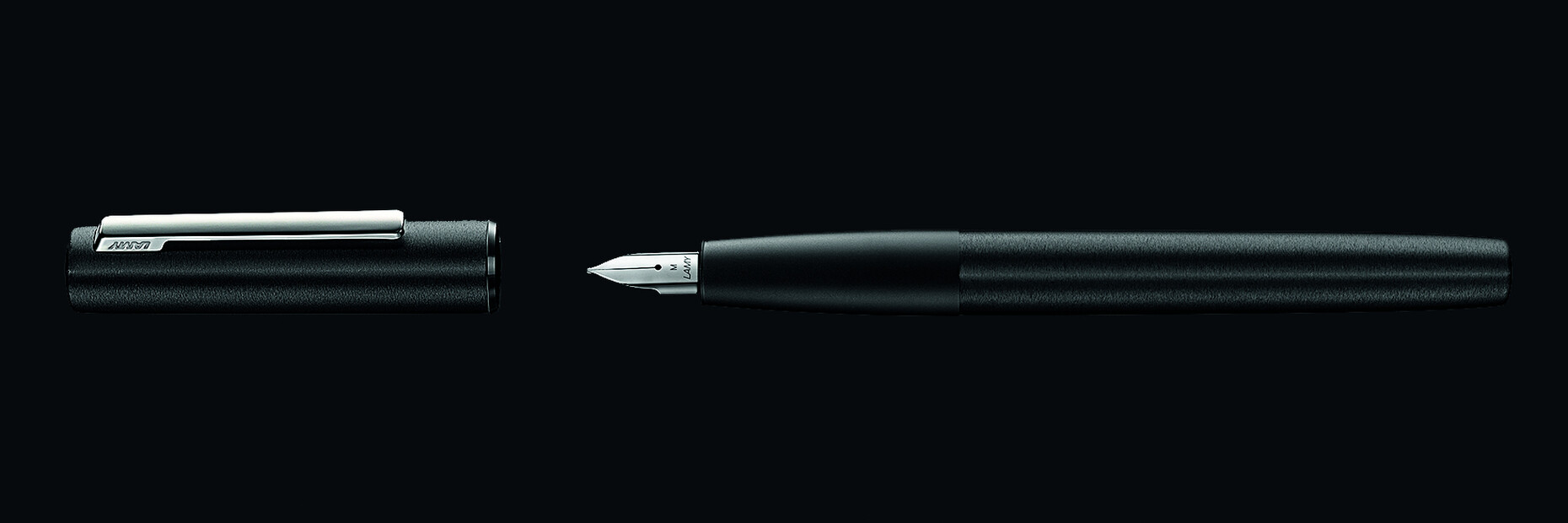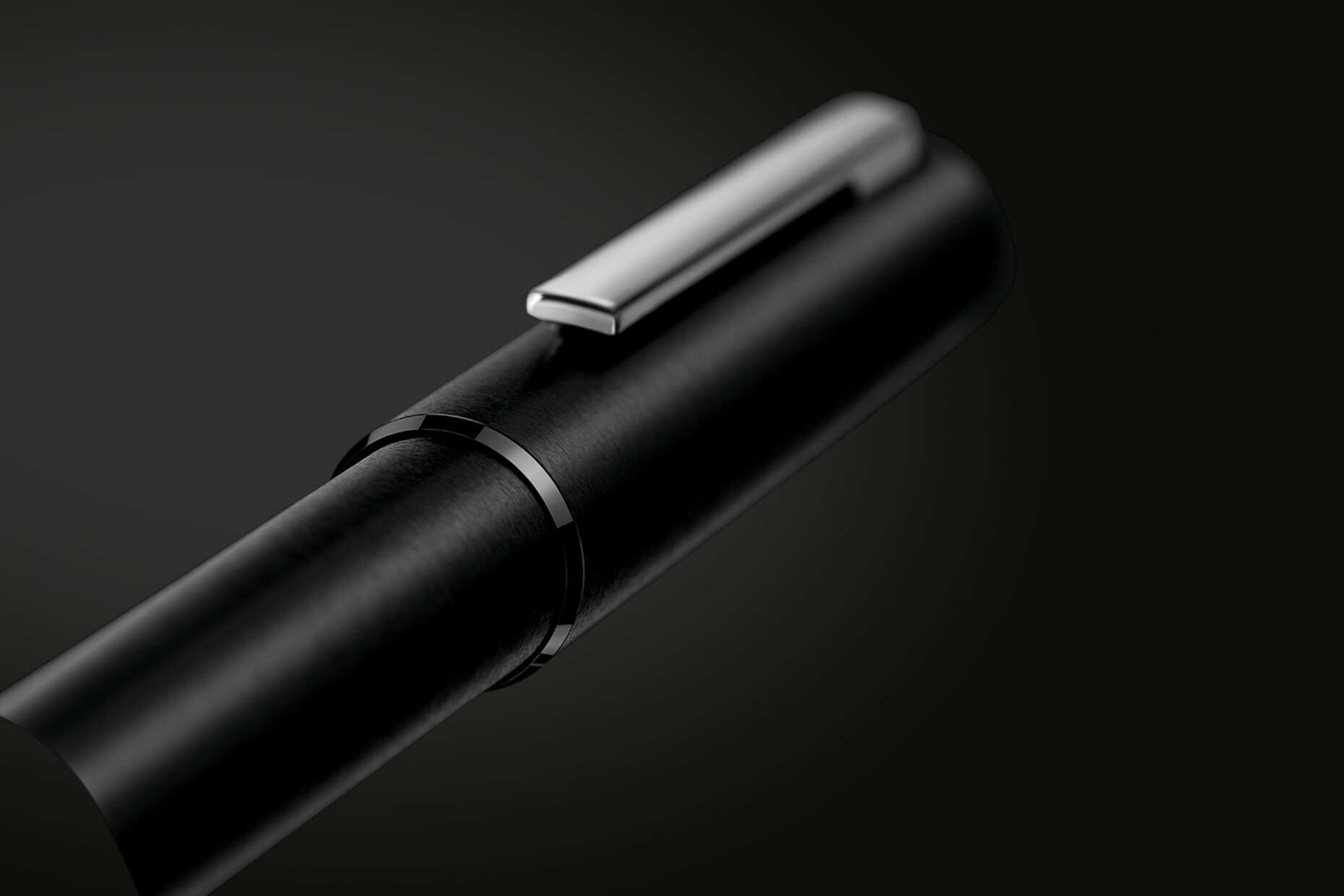Writing utensils
The task of designing writing utensils such as fountain pens is a real challenge. Cheating is impossible. Even the tiniest of details counts. The writing mechanism itself tends to play a subordinate role; it has usually withstood the test of time and simply has to be adapted to the new product. The designer’s task thus focuses mainly on such fundamental factors as materials, volume, weight, balance and surface, all of which go to make up the shape and are therefore indispensable if the discussion centers on form. All of this not only has to be heeded during the design process, but also determines the overall production process. And it is the shape (or body) of the writing utensil – in the case of a fountain pen in its closed state this consists of the shaft, cap and clip – that the user then perceives as constituting a uniform entity.
Nowadays, the masses of cheaply made ballpoints, gel pens and felt-tips tend to consist of a colorful variety of utensils – and when you hold them in your hand you soon realize they try to make up with graphic frills for what they lack in taste. Things are different when it comes to a perfectly designed fountain pen (or a writing set made up of a fountain pen, a ballpoint and a rollerball) and decidedly more complex. If the express focus is not on shape, materials, color and price (as is the case with designing fountain pens for school children, where didactic aspects play as much a role as do ergonomic criteria) as a rule the traditional tends to prevail in the design of fountain pens.
Most manufacturers opt for models with a nostalgic touch, with gleaming gold or silver rings, similar clips, and artistically engraved gold nibs that emulate those of yesteryear. They take a defensive approach in the belief that in an age of electronic communication only very rarely do things get written by hand. Given that today people purportedly only type using two thumbs on a virtual and miniature keyboard of some smartphone or other, the fountain pen is meant to at least be a luxurious exception and offer an ancient status symbol when writing Christmas or birthday cards, when signing contracts or composing personal letters.
Ever since 1966, the Lamy brand has stood for the conviction that fountain pens by no means have to look all fuddy-duddy, replete in nostalgia and prejudice. What began back then with the Lamy 2000 designed by Gerd A. Müller has over the past 50-plus years been carefully nurtured by countless designs by such renowned masterminds as Mario Bellini, Franco Clivio, EOOS, Wolfgang Fabian, Naoto Fukasawa, Phönix Design, Richard Sapper, Sieger Design and Hannes Wettstein. Anyone who values a good, contemporary design invariably grabs a Lamy.
Lamy has now launched a new writing utensil series (fountain pen, ballpoint and rollerball) made of deep-drawn aluminum with a design courtesy of Jasper Morrison: Lamy Aion. We took a closer look at the set’s fountain pen in the “Black” version (it’s also available in olive-silver). The very first impression: Jasper Morrison has come up with a very special fountain pen of poignant simplicity. If the term “super normal,” originally intended to designate anonymous design, had not been excessively used to describe Morrison’s oeuvre, then it would certainly apply here. What you have here seems to be so utterly obvious a design that the fountain pen is actually quite extraordinary.
It seems abundantly clear that Jasper Morrison sets no store by sentimentality. Nowhere does the pen even remotely have frills: The matt black shimmering body of deep-drawn anodized aluminum seems to be a perfect one-piece. There is no intimation of ornamentation, rings or applications of any kind. The seemingly solid high-gloss clip merely serves to round out the overall concept. Above all in the “black” version all the elements of the casing combine to form a compact unit. The cylindrical basic shape almost imperceptibly tapers towards the end and (unlike the brushed surface) the polished grip, creating a slight bulge when the cap is taken off, which explains why the essentially voluminous body is not bulky but decidedly elegant. Moreover, the aluminum casing shows just how perfectly the pen is made.
The Aion stands out clearly from all the other familiar fountain pens. It is perhaps most closely allied (assuming one wishes to compare its quite incomparable look) to the Lamy 2000 – in terms primarily of the latter’s likewise compact shape and matt surface. Yet there are striking differences, and not just as regards the materials and tactile properties.
The Aion fountain pen is also eye-catchingly unique because, for all its elegance, is has something rough, sturdy and stable about it. As a writing utensil, the emphasis is definitely on the utensil. Its industrial character resembles that of a robust but by no means clumsy tool that you automatically grab when you need it. And fittingly, the newly designed stainless-steel nib feels harder than gold versions – whereby (the only slight downside) the latter glide more softly and smoothly across the page and yet follow the hand just as precisely. Not that anyone will really worry about this, since the Aion fountain pen costs a mere 49 Euros, and your choice of pen always depends on your writing habits, anyway. The Aion is simply a well-conceived writing utensil if there ever was one.











